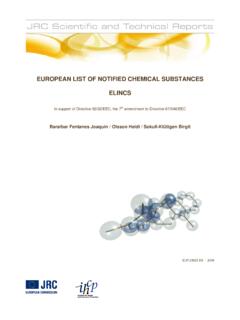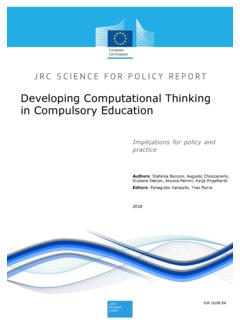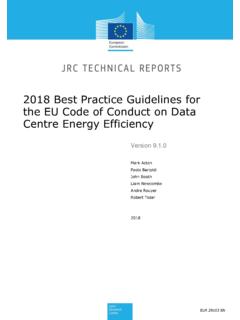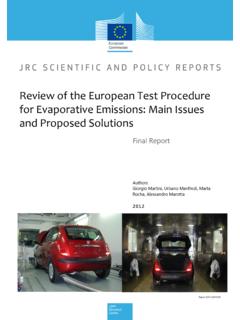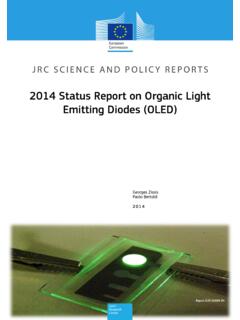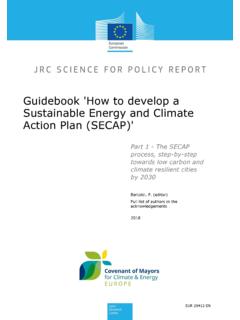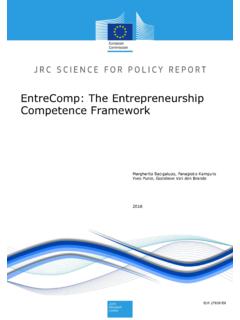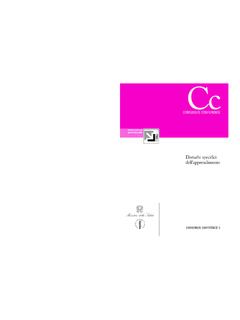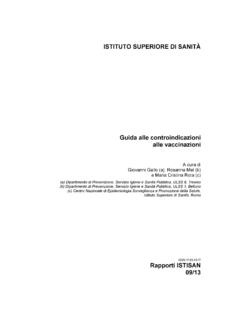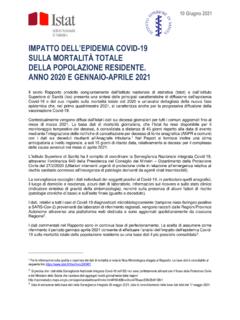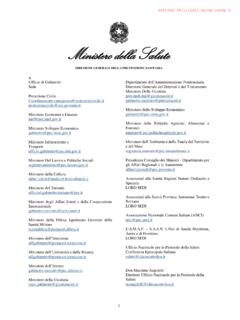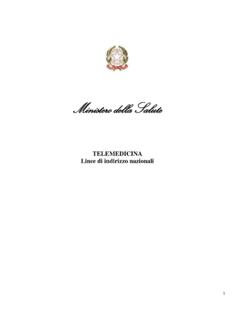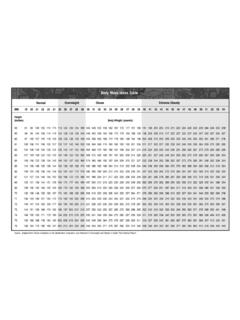Transcription of Guidance Document on the Estimation of LOD and LOQ ...
1 Thomas Wenzl, Johannes Haedrich, Alexander Schaechtele, Piotr Robouch, Joerg Stroka Guidance Document on the Estimation of LOD and LOQ for Measurements in the Field of Contaminants in Feed and Food 2016 EUR 28099 EN This publication is a Technical report by the Joint Research Centre, the European Commission s in-house science service. It aims to provide evidence-based scientific support to the European policy-making process. The scientific output expressed does not imply a policy position of the European Commission. Neither the European Commission nor any person acting on behalf of the Commission is responsible for the use which might be made of this publication. Contact information Name: Thomas Wenzl Address: JRC Geel, Retieseweg 111, B-2440 Geel E-mail: Tel.: +32 14 571 320 JRC Science Hub EUR 28099 EN ISBN 978-92-79-61768-3 (PDF) ISSN 1831-9424 (online) (online) European Union, 2016 Reproduction is authorised provided the source is acknowledged.
2 All images European Union 2016, Image on cover page was produced with GeoGebra ( ) How to cite: Wenzl, T., Haedrich, J., Schaechtele, A., Robouch, P., Stroka, J., Guidance Document on the Estimation of LOD and LOQ for Measurements in the Field of Contaminants in Feed and Food; EUR 28099,Publications Office of the European Union, Luxembourg, 2016, ISBN 978-92-79-61768-3; 2 01 6 Guidance Document on the Estimation of LOD and LOQ for Measurements in the Field of Contaminants in Feed and Food 4 Editors Thomas Wenzl EU Reference Laboratory for Polycyclic Aromatic Hydrocarbons Johannes Haedrich and Alexander Schaechtele EU Reference Laboratory for Dioxins and PCBs in Feed and Food Piotr Robouch EU Reference Laboratory for Heavy Metals in Feed and Food Joerg Stroka EU Reference Laboratory for Mycotoxins 5 Acknowledgement The editors wish to acknowledge the contributions to this Guidance Document by members of the networks of national reference laboratories for heavy metals in feed and food, for mycotoxins, for polycyclic aromatic hydrocarbons, for dioxins and PCBs in feed and food.
3 Special credits are given to the Working Group for Measurement Uncertainty in PCDD/F and PCB Analysis (CWGMU), which had major involvement in the elaboration of procedures for estimating LOQ in the area of persistent organic pollutants. Members of NRL networks for HM, PAHs, Mycotoxins Pedro Burdaspal Centro Nacional de Alimentaci n, Agencia Espa ola de Seguridad Alimentaria y Nutrici n (AESAN), Majadahonda, Spain Timo Kapp Bundesamt f r Verbraucherschutz und Lebensmittelsicherheit BVL, Berlin, Germany Heidi Amlund National Institute of Nutrition and Seafood Research NIFES, Bergen, Norway Udo Jensen Department of Food Chemistry, Danish Veterinary and Food Administration, Ringsted, Denmark, Mark ta Posp chalov st edn kontroln a zku ebn stav zem d lsk KZ Z, Region ln odd len Brno, Brno, Czech Republic Marina Patriarca Instituto superiore di Sanit , Rome, Italy Monika Mania Laboratory of Department of Food Safety, National Institute of Public Health National Institute of Hygiene, Warsaw, Poland Mary Doris Gambin Public Health Laboratory, Valletta, Malta Claude Schummer Service de Serveillance Alimentaire, Laboratoire National de Sant , Dudelange, de Luxembourg Kirsti Nuotio Finish Customs Laboratory, Tekniikantie, Finland Eftychia Christou State General Laboratory, Ministry of Health.
4 Nicosia, Cyprus Hans Mol RIKILT Institute of Food Safety, Wageningen, The Netherlands Philippe Debongnie CODA-CERVA Veterinary and Agrochemical Research Centre, Tervuren, Belgium Peter Cuhra Czech Agriculture and Food Inspection Authority, Prague, Czech Republic Members of the Working Group for Measurement Uncertainty in PCDD/F and PCB Analysis Roberta Ceci Istituto Zooprofilattico Sperimentale dell'Abruzzo e del Molise "G. Caporale", Teramo, Italy Gianfranco Diletti Istituto Zooprofilattico Sperimentale dell'Abruzzo e del Molise "G. Caporale", Teramo, Italy Gauthier Eppe Centre de Recherche Analytique et Technologique (CART) University of Li ge, Li ge, Belgium Alwyn Fernandes Food and Environment Research Agency (FERA), York, UK Jerry Hart SGS North America Inc., Environmental Service, Wilmington, NC, USA Helge Hove The National Institute of Nutrition and Seafood Research (NIFES), Bergen, Norway Leondios Leondiadis National Center for Scientific Research (NCSR) Demokritos , Athens, Greece Rainer Malisch European Union Reference Laboratory (EU-RL) for Dioxins and PCBs in Feed and Food, Freiburg, Germany Philippe Marchand Laboratoire d Etude des R sidus et Contaminants dans les Aliments (LABERCA), Nantes, France Wolfgang Moche Umweltbundesamt, Vienna, Austria Georges Scholl Centre de Recherche Analytique et Technologique (CART) University of Li ge, Li ge, Belgium Giampiero Scortichini Istituto Zooprofilattico Sperimentale dell'Umbria e delle Marche, Perugia, Italy Yves Tondeur Independent expert, USA Stefan van Leeuwen RIKILT -Institute for Food Safety, Wageningen, NL Irene Vasileiadou National Center for Scientific Research (NCSR)
5 Demokritos , Athens, Greece 6 Table of Contents 1. Scope and Field of Application .. 7 2. Acronyms and Definitions .. 8 3. Principles .. 11 General .. 11 Mathematical Assumptions .. 12 4. Samples for LOD/LOQ Estimation Studies .. 13 5. Limit of Detection .. 14 Estimation of LOD via Blank Samples .. 16 Estimation of LOD via Paired Observations .. 18 Estimation of LOD via Calibration Approach .. 19 6. Limit of Quantification .. 20 7. Limit of Quantification for the Analysis of Persistent Organic Pollutants, in particular, PCDD/F and PCBs, using Isotope Dilution Mass Spectrometry .. 22 Estimation of LOQ from S/N Calculations .. 24 Estimation of LOQ from Calibration Standards .. 26 8. Practical Implementation of LOQ Estimation in the Field of PCDD/F and PCB Analysis .. 27 Estimation of Congener-based LOQs from S/N Calculations .. 27 Estimation of Congener- based LOQs from Calibration Standards .. 31 Use of Procedural Blanks.
6 31 9. Estimation of LOQs for Sum Parameters .. 32 10. References .. 33 ANNEX .. 34 A1. Mathematical approaches .. 34 Critical Value and LOD based on 34 Critical Value and LOD based on Paired Observations .. 37 Critical Value, and LOD based on Calibration .. 40 Signal-to-Noise Ratio (S/N) .. 43 Examples .. 48 Estimation of LOD and LOQ based on the Analysis of Blank Samples .. 48 Estimation of LOD and LOQ based on Paired Observations .. 50 Estimation of LOD and LOQ from Calibration Samples .. 53 of tables .. 55 List of figures .. 56 7 1. Scope and Field of Application The European Union Reference Laboratory (EURL) for Polycyclic Aromatic Hydrocarbons (EURL PAH), the EURL for Heavy Metals in Feed and Food (EURL HM), the EURL for Mycotoxins (EURL Mycotoxins), and EURL for Dioxins and PCBs in Feed and Food aim to provide with this Document Guidance to official food control in the EU on the Estimation of the limit of quantification of analytical methods for the determination of individual substances in the field of contaminants in feed and food.
7 The Document focusses on Estimation of the limit of detection (LOD) and/or limit of quantification (LOQ) of polycyclic aromatic hydrocarbons (PAHs), heavy metals (HM), mycotoxins, and polychlorinated dibenzo-p-dioxins (PCDDs), polychlorinated dibenzofurans (PCDFs) and polychlorinated biphenyls (PCBs). The concept presented here consists of two major routes: The first route responds to the requirements for determination of PAHs, HMs and Mycotoxins. The second route corresponds to PCDD/F and PCB analysis, where results are calculated as sum-parameters and expressed in toxic equivalents (TEQs), converting thereby congener concentrations together with estimated LOQs using toxic equivalency factor (TEFs) into TEQs. Due to the nature of this more complex procedure, emphasis is put in the area of PCDD/F and PCB analysis on the LOQs, while LODs are of minor consequence. Terminology in this Guidance Document was adapted to the chemical analysis of contaminants in feed and food; hence, some of the general terms defined and used in international standards were replaced by more specific terms applicable to analytical chemistry.
8 The presented statistical-mathematical approach is based on elements taken mainly from DIN 32645:2008-11 (DIN 2008) and ISO 11843-2:2000 (ISO 2000). This Document covers only quantitative methods of analysis. The authors believe that LOD and LOQ values derived from the application of the presented experimental methodologies converge to a certain degree. Estimation of LOD/LOQ values based on blank measurements, and from calibration data is described. Signal-to-noise ratios are applied in the area of PCDD/Fs and PCBs. Mathematical terms and statistical background are presented as well. This guide Document shall be applied systematically if measurement results are used for monitoring purposes and exposure modelling. However, authors are aware that precise knowledge of LOD/LOQ may not be required when assessing compliance with maximum levels exceeding LOD/LOQ. This Guidance Document shall be applied if maximum levels and analysis results are close to the expected LOQ.
9 The authors acknowledge that the presented approach has its limitations and may not be generally applicable to all cases. 8 2. Acronyms and Definitions a: Intercept of the calibration curve : Probability of detecting (erroneously) that a substance is present while truly, it is not (false positive results; type I error) : Probability of (erroneously) not detecting that a substance is present while truly, it is (false negative results; type II error) b: Slope of the calibration curve (determined by linear regression over a concentration range with a maximum calibration level equal to 10 times the level of LOD) Background subtraction: Correction of the signal of a test sample by the signal of the background. Blanks, procedural blanks, or only pure solvents may be appropriate for determining the background, depending on the analysis task. The background signal may be representative for a single test sample only, or for a series of test samples.
10 Blank: Test sample in which the analyte is absent. It is characterized by a mean response value equal to zero ( = 0) and standard deviation b, which is approximated by sy,b Test method: Process covering both sample preparation and instrumental measurement Confirmatory method: a method that provides full or complementary information enabling the PCDD/Fs and dioxin-like PCBs to be identified and quantified unequivocally at the maximum or in the case of need at the action level. Such a method utilises gas chromatography/high-resolution mass spectrometry (GC-HRMS) or gas chromatography/tandem mass spectrometry (GC-MS/MS) HM: Heavy metals iLOD: Instrumental limit of detection iLOQ: Instrumental limit of quantification K: Number of replicate analyses of the background/blank sample from which the mean signal forms a single data point for background correction LOD: Limit of detection: Analyte content which can be distinguished from the blank with an error probability of (1- ) LOQ: Limit of quantification: Analyte content which can be determined with a certain level of precision M: Number of replicate analyses of the test sample from which the mean signal forms a single data point for background correction m: Number of replicate analyses on the test sample N: Noise height n: Number of replicate analyses on the blank sample 9 p: Number of calibration levels PAH.
